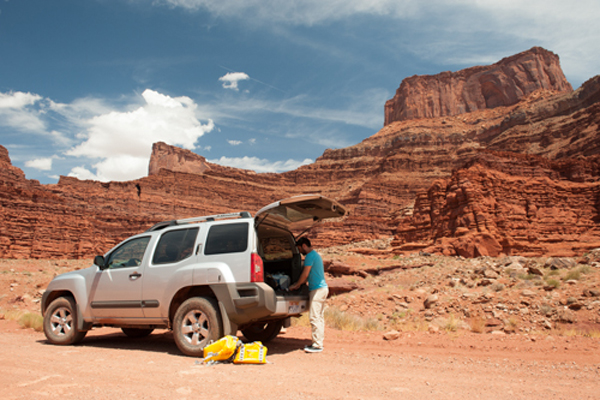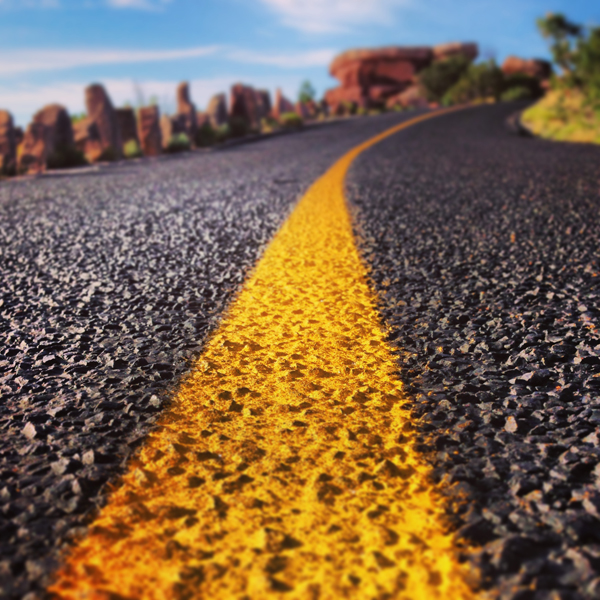Editor’s note: Two of our adventurous and always-curious designers took advantage of a visit to the Summer Outdoor Retailer show in Salt Lake City, Utah to make a side trip to Moab. Luis and Ryan headed out to canyon country armed with the new DryZone duffle and backpack (waterproof, but also dirt, dust and sand-proof) and Flipside Sport 20L.
Eager to test gear and happy to meet fellow photographers, they found beautiful vistas, the challenges of a high-desert environment and lots of folks who know, use and like Lowepro bags.
Ryan took a bit of time to tell us about their experiences.

Pinghua Young from Mountain View, California using his Lowepro Fastpack to stabilize his tripod for timelapse with a GoPro
What was it like using our new DryZone bags for a shoot in a red-rock wonderland?
“It was really insightful to have an opportunity to get down-and-dirty in field use with these two products. At first it may seem a little odd to take a waterproof bag into a desert, but the more we used them, the more the value of these materials became evident. They are waterproof so therefore also great at protecting gear from dust, dirt, mud, sand and other nasty environmental stuff that is just waiting to try and get into your bag and do damage to your equipment. Luis loved using the high ‘collar’ on the roll-top as a dust-free space to change lenses, and the yellow color made it really easy to see what he was doing in there.
The Backpack was carried on hot days over several miles of approach to a couple locations and was comfortable. The construction of the bag is pretty robust. We use heavy laminated materials that are welded together making for a tough construction.”
How did they help in terms of their key design feature?
“Protection is big with these bags. Nothing got in that we didn’t want there. The roll -op on the backpack allowed for a lot of extra gear to be stuffed in right on top of the camera compartment. Also, the inserts could be removed so that extra gear like jackets could be packed instead giving us one bag for camera gear and one bag for other essentials.”
What camera gear did you pack to get these images?
“Between the two of us, we took a Nikon D700, Nikon 24-70mm f/2.8, Nikon 14-24mm f/2.8, Nikon 70-200mm f/2.8, Sony NEX 7, and a fun Rokinon fisheye lens. We also carried a tripod, circular polarizer, plus few extra memory cards, batteries, a couple of strobes and a collapsible softbox to experiment with.”
Can you share any tips for getting ideal shots in canyon country?
“A real eye opener for me was that in the extreme of the desert-like environment there are still great shots to be captured in the middle of the day. I had visions of getting up early for sunrise then scurrying back to the safety of air conditioning during the middle of the day, but it turned out that the heat was bearable and that the high-desert clouds, sky and rocks all kept their color rather well during the midday light. Again this was a real surprise.
So one tip from me is this: always get up for sunrise and always stay for sunset. These are of course the best moments for light, but also it allows you to be open to exploring other areas of this kind of park during midday. You might just be surprised by what you find…
And here are a couple of gear tips to share. For these environments I think the expansive views require a wide-angle lens to really do them justice. Luis shot a fisheye – which was great, and I was shooting at a 24mm focal length a lot and was wishing for something a bit wider. I talked to another photographer at Delicate Arch in Arches National Park who was shooting a Canon 24-105mm and he would have preferred a wider-angle lens. It seems that all these sweeping vistas really require the right lens to get it all in.”
Check back for our follow-up story on Luis and Ryan’s trip. Some of the travelers and photographers they met will share their insights and impressions of the Lowepro bags they tested out in canyon country — as well as their own imagery. We’ll share their gear reviews in the near future. So please stay tuned!
In the meantime, read more about our DryZone BP 40L and DF 20L and Flipside Sport 20L.






